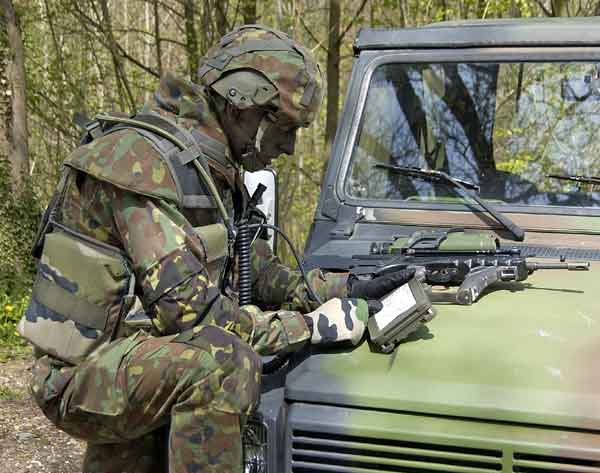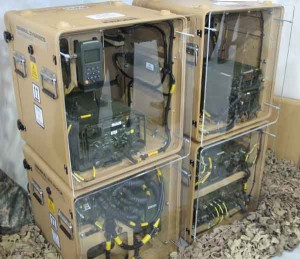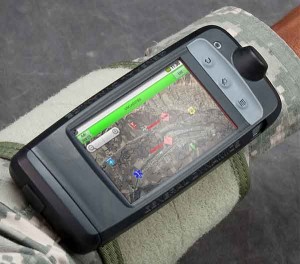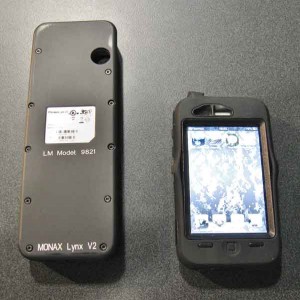
The Système d'Information Terminal Combattant Débarqué (SIT COMDe display from Sagem used in the FELIN soldier system (Sagem)
In practise this means that users of the company CP must be able to use tactical data reporting and command systems like the Force XXI Battle Command Brigade and Below, collaborative environments such as the Command Post of the Future, and the Advanced Field Artillery Tactical Data System (AFATDS) to plan and execute fire support.
The solution must also be usable on a variety of different mobile platforms, such as MRAPS, HMMWVs or helicopters in order to be able to support dismounted, mechanised or airborne units.
The US Army is likely to identify the best solution through the NIE, and that process has already started in NIE 21.1 in November 2011. During this three possible variants of the company CP were tested. One of these was based on a Caiman MRAP, which could be used for mission critical tasks when embarked and on the move, and then a more elaborate version could be established in a tent, or adjacent building.
The US Army is likely to identify the best solution through the NIE, and that process has already started…
The second variant tested on NIE 12.1 was the “Trailer Mounted Support System-Medium, a tent-based system mounted in a trailer, and including an 18-kilowatt generator and an environmental control unit. The system uses a SNAP terminal to provide satellite connectivity.
The third variant included technology provided by DRS Tactical Systems which allows all users of the CP flexible access to a range of communications and C2 systems. Few details are publicly available.
In NIE 12.2, which will take place in April/May 2012, two more variants of the Company CP will be tested, although no details are yet available. Presumably, once this evolution has been completed, the successful version will be selected and a contract awarded, although the procurement process based on NIE is still in the process of being finalised to ensure all the legal aspects for a fair competition are covered. NIE 13.1 in November 2012 might be used as an opportunity to test the chosen solution and make modifications before fielding begins.
The US Army has not been alone in providing solutions to the need to provide C2 equipment for its dispersed bases. In response to a UK MOD Urgent Operational Requirement for a modular and flexible C2 capability in locations where it is inappropriate to use either command vehicles or larger fixed installations, such as FOBs or Patrol Bases (PB), General Dynamics UK (GDUK) developed the Modular Deployed Operations Room (M-DOR).

A 4-case version of the Modular Deployed Operations Room (M-DOR) from GDUK shown at the DSEi exhibition in London in 2011. (Giles Ebbutt)
M-DOR is a lightweight, transportable modular system contained in a number of transit cases, each of which provides a specific function and all based around the components of the UK’s Bowman radio system. Common to all configurations are power distribution and ancillaries boxes. To these can be added HF, VHF, Network and High Capacity Data Radio boxes. Increasing the functionality and the number of boxes increases the capability, with the maximum being provided by two VHF, two HF, a Network and an HCDR box with the ability to communicate Bowman C2 data, ISR and other tactical information.
M-DOR was fielded during 2011 to British Army locations in Afghanistan, with the latest Bowman CIP 5.4 configuration.
While connectivity and communications capacity is one issue for the disadvantaged user, another is the ability to get access to C2 applications which are regularly used by those in higher headquarters and with better communications, which are often stovepiped and not integrated. In an effort to overcome this, the US Army Programme Executive Officer-C3T (PEO-C3T) has developed the Battle Command Collapse strategy, which is intended to breakdown the barriers between the different functional C2 systems. The principal vehicle for achieving this has been to use the Command Post of the Future (CPOF) from GDC4S, already the main collaborative working system, as a visualisation tool.
Lockheed Martin IS & GS Defense (LM IS&GS-D) has now developed the Battle Command Web (BC Web), which is also known in the US Army as C2 Web or Mission Command Web. This provides a web-based viewer of the COP using a thin client interface, and gives access to some of the functionalities within the different elements of the US Army Battle Command System, a suite of software applications that spans the ground combat functions. It can even be provided on a handheld device.
In October 2011 CPOF, the Tactical Airspace Integration System (TAIS) and the Publish and Subscribe Server (PAS) had been integrated and work was in hand to add AFATDS, the Manoeuvre Control System, and the Tactical Ground Reporting (TIGR) system. A software development kit is also being produced to assist software manufacturers to develop the necessary interfaces for other applications.
The ultimate aim is to collapse all the systems into a virtualized environment which can be accessed via a single viewer, using cloud technology, with up to 80% of mission command functionality available via the web environment. Different users would have different access according to their specific profiles.
The system is already being used operationally in order to gather initial feedback and has been submitted for NIE laboratory evaluation with a view to seeking an invitation to take part in NIE 12.2.
Of course, the ultimate disadvantaged user is the junior commander on foot, who has only a handheld display or perhaps a tablet computer to run C2 applications and a low-capacity radio to provide connectivity. Until about two years ago such displays were ruggedized PDA variants such as Elbit Systems of America’s RPDA which was adopted by a number of US programmes, and virtually every manufacturer of ruggedized computers or displays offered a handheld capability. In some cases these were developed for a specific programme; the French army’s Fantassin à Équipement et Liaisons Intégrés (FELIN) soldier system includes the Système d’Information Terminal Combattant Débarqué (SIT COMDe) display, a small tablet display powered by the system computer running a variation of the Sagem SIT battle management system.

The GD300 computer, which is one of the contenders for the US Army’s JBC-P handheld competition, in a wrist mounted configuration. (General Dynamics)
As bandwidth capacity and data speeds for the dismounted user have increased it has brought greater access to a wide range of information, including the possibility of streaming video. However, such capabilities always come at a cost, and the debate has been raging for some time over how much information a soldier on foot actually needs. Any device that a soldier might use when in combat must be as simple as possible to use, and preferably come with a minimum training burden.
The advent of the smartphone was therefore seized upon as the possible answer to this conundrum. Like many similar developments, using a smartphone is second nature to the vast majority of those who make up dismounted combat forces; it is already a significant element in the ordering and running of their everyday lives. Because of this the training requirement is relatively small, and more importantly that familiarity reduces any intrinsic opposition to the concept.
The current challenge is therefore whether the power, versatility and familiarity that is embodied in the smartphone can be harnessed.
The US Army is currently conducting a competition for the device which will be used for the dismounted version of its future battle management system, the Joint Battle Command – Platform (JBC-P), having mandated the Android operating system for these and other handheld devices. The two competitors are the GD300 computer from GDC4S and a device from DRS Technologies. Although this competition is specifically linked to the JBC-P programme, it is more than likely that the winner will be incorporated into other programmes such as the Nett Warrior soldier system. Although these both incorporate aspects of the smartphone in their technologies, notably in the user interface, they are not just repackaged smartphones.
The current challenge is therefore whether the power, versatility and familiarity that is embodied in the smartphone can be harnessed.
Apart from their possible physical vulnerability, smartphones have two principal drawbacks on the battlefield which counterbalance their ease of use and versatility: security and communications. Cryptographic protection can increase the power requirement and the physical size and weight, negating the advantage of using COTS equipment. ITT Excellis may have found a solution to this in its GhostRider concept, in which the crypto processor is incorporated into the battery to form a single module which can be fitted into a commercial smartphone with no change to the form factor. This was certified by the US NSA in mid-2011 and development work continues.
But the requirement to provide a fully secure cryptographic solution may have receded, at least in the US, in that there has recently been some relaxation in the rules for security at the lower tactical level.
Connectivity is a different matter. Smartphones depend on a permanent infrastructure and a network of bases stations, a commodity which may be in short supply on the battlefield, even in today’s operational environment. A number of manufacturers have therefore been developing solutions that enable deploying troops to take their own “cell phone tower” with them, with wireless or cellular hubs installed in vehicles which accompany troops.
Lockheed Martin’s MONAX system connects a COTS smartphone to a ground or airborne MONAX XG Base Station providing a 4G deployable cellular system which is also interoperable with current military networks. The commercial smartphone is twinned with a Lynx portable sleeve, which provides the connectivity to the base station. The original design had the phone physically mounted in the sleeve, but in order to accommodate a range of different phone form factors the two are now separate. The sleeve also acts as a mobile wifi hotspot via which any wifi-enabled device can connect to the network. The result is an Everything Over IP (EOIP) network which can carry voice, data and streaming video.
As well as allowing the user to use a range of applications on the smartphone the MONAX network provides access to a range of military C2 and intelligence systems through connections to existing networks. This is achieved through the use of a Universal Communications Protocol (UCP) device which acts a bridge between tactical radio nets and MONAX. The MONAX base station can be mounted on a vehicle or on a tower or aerostat in a base location. In the former it can provide up to 5kms coverage, but as much as 70 kms has been achieved using an aerostat, which equates to an area of 3800km2.
Solutions such as this may be the way of the future for the individual soldier, who is used to his (or her) smartphone providing communications and applications for every aspect of life.





